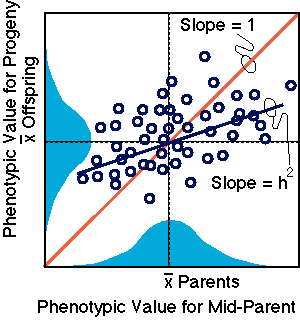Back to 2. Genes and Behavior
Side Box 2.5. Heritability
A central aspect of Darwin's theory of evolution includes a key statement
regarding the action of natural selection on traits that are heritably transmitted
between parents and offspring.
 Darwin's cousin, Sir Francis Galton coined the term
for regression based on the observation that the regression line which predicts
offspring phenotype from parent's phenotype always has a slope less than
one. The slope of the parent-offspring regression line is also known as
heritability. The heritability for any phenotypic trait describes
the proportion of the offspring's phenotype that we can predict from a knowledge
of the phenotype of both parents. The prediction is not exact and includes
some error about the regression line because offspring phenotype includes
environmental effects in addition to polygenic factors inherited from parents.
Finally, another formulation of heritability is derived from Equation
2.1 (P = G + E):
Darwin's cousin, Sir Francis Galton coined the term
for regression based on the observation that the regression line which predicts
offspring phenotype from parent's phenotype always has a slope less than
one. The slope of the parent-offspring regression line is also known as
heritability. The heritability for any phenotypic trait describes
the proportion of the offspring's phenotype that we can predict from a knowledge
of the phenotype of both parents. The prediction is not exact and includes
some error about the regression line because offspring phenotype includes
environmental effects in addition to polygenic factors inherited from parents.
Finally, another formulation of heritability is derived from Equation
2.1 (P = G + E):
heritability = h2 = G / P = G / (G + E).
Heritability is the proportion of phenotypic variation (P = G + E) that
is due to genetic causes (G). Because phenotypic variation is larger than
genetic variation, heritability should have a slope less than one. However,
it is possible for measured heritability to be confounded with environment.
For example, if parents and offspring share a common environmental factor
which makes them more similar by upbringing than genes alone heritability
could be inflated.
In principle, a regression based upon any related individuals can be
used to estimate heritability. Sibs share the additive effects of alleles,
much like parents resemble offspring because of the additive effect of alleles.
We could use a correlation between sibs to predict h2, however, sibs have
an even greater tendency to share common environmental factors owing to
their common rearing environment, and h2 derived from sibs is likely to
be inflated owing to shared environment. Sibs not only share additive effects
of alleles, a common environment, but they also share another component
of variation referred to as dominance variation that makes them resemble
each other more so than they do their own parents.
Back to 2. Genes and
Behavior
 Darwin's cousin, Sir Francis Galton coined the term
for regression based on the observation that the regression line which predicts
offspring phenotype from parent's phenotype always has a slope less than
one. The slope of the parent-offspring regression line is also known as
heritability. The heritability for any phenotypic trait describes
the proportion of the offspring's phenotype that we can predict from a knowledge
of the phenotype of both parents. The prediction is not exact and includes
some error about the regression line because offspring phenotype includes
environmental effects in addition to polygenic factors inherited from parents.
Finally, another formulation of heritability is derived from Equation
2.1 (P = G + E):
Darwin's cousin, Sir Francis Galton coined the term
for regression based on the observation that the regression line which predicts
offspring phenotype from parent's phenotype always has a slope less than
one. The slope of the parent-offspring regression line is also known as
heritability. The heritability for any phenotypic trait describes
the proportion of the offspring's phenotype that we can predict from a knowledge
of the phenotype of both parents. The prediction is not exact and includes
some error about the regression line because offspring phenotype includes
environmental effects in addition to polygenic factors inherited from parents.
Finally, another formulation of heritability is derived from Equation
2.1 (P = G + E):